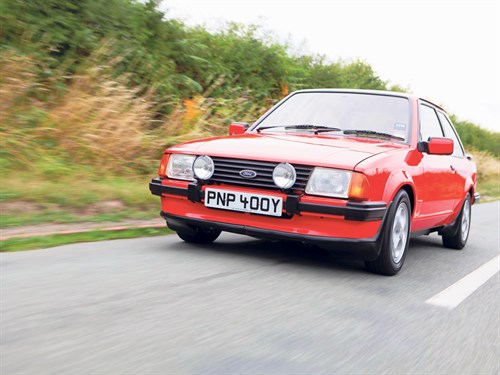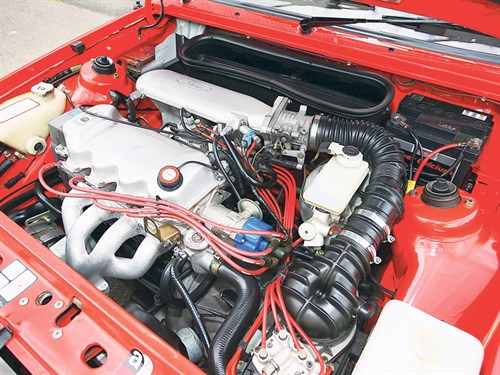The sporting Escort gained market share as the 1980s wore on. We examine their status as a modern classic...

The Ford XR3i was first released in January 1983. Initially available as the carburettored four-speed XR3, it was the introduction of Bosch K-Jetronic fuel injection that added the I to the name and credibility to the model. With 105bhp and a top speed of 120mph, Ford’s hot hatch came good just at the right time.
VITAL STATISTICS
1985 ford xr3i
Engine 1597cc/4-cyl/SOHC
Power (bhp@rpm) 105bhp@6000rpm
Torque (lb ft@rpm) 101lb ft@1400rpm
Top speed 116mph
0-60mph 8.8sec
Consumption 32mpg
Gearbox 4/5-speed manual
WHAT TO LOOK FOR
BODYWORK & CHASSIS
While base model Escorts had plain metal, the winged, wheel-arched and skirted XR3i was covered in plastic add-ons just like the shoulder-padded fashions of the era. In period, this meant that Ford XRs looked less rusty than their lesser-specced sisters as the cars aged. But now, with rot able to take a good, hidden hold of steel, it’s easy to buy a car needing much rectification.
Sills and rear wheel arches are the first grot-spots to examine. Check for incorrect clips or fixings, or the use of cyanoacrylate body sealer to hold components on. If you find any, alarm bells should be ringing. Screen bases and front wings can also rot and when you lift the bonnet, the story doesn’t end. Battery trays and the bulkhead below can rot through. The inner wings can disappear, as can the triangular bonnet landing panels at the top of the slam panel.
ENGINE
The CVH, or Compound Valve Hemispherical engine was a modern advanced design for its era. It was Ford’s first European engine to feature hydraulic valve lifters, reducing adjustment time in service, and giving quieter running. While less beset by damp starting problems than previous Ford motors, the CVH did have its own set of special needs – the cambelt needs changing every 36,000 miles, and needs checking either physically or in a paperwork trail that it has been done.
Oil changes need to be frequent on a CVH, no matter what the Ford schedule says, because the engines are prone to black sludge, which can block oilways. Oil pick-up pipes are particularly prone to this, and it is often easier to change the gauze and pick-up tube than try to clean it. You can access this inside the sump. At the top end, motors can get rattly and if any oil starvation happens, the CVH can be prone to kicking a leg out of bed too, so watch that oil level. When servicing, take your 10mm, 11mm and 13mm spanners and go around every nut and bolt you can find. Many of them will have ‘eased off’ in use and this engine always seems to need a nip up, not helped by the revs you need to pile on to get the full 105bhp released.

RUNNING GEAR
Brakes and wheel bearings are generally durable, as are driveshafts. Watch for the mechanical anti-lock brakes on the fronts of facelifted models, and read up online before attempting to work on or service them. Four-speed gearboxes are generally durable, but the five-speed gearbox can have some issues. Watch for poor synchromesh on gearchanges initially. Then observe the speedo needle carefully on the test drive. If it seems sluggish, flicky or doesn’t work, then suspect imminent failure of the diff bearings! Excess run-out as the bearings age causes the speedometer drive pinion to become disengaged, so an apparent speedo fault could mean a gearbox and diff rebuild!
INTERIOR
Inside an XR3i was considered plush in its day. Now you’ll be watching out for worn seat bolsters, crusty carpets and dashboard deterioration. Cigarette burns in upholstery can be common. Check for delaminating windscreens, a sure sign that moisture may be getting past the windscreen seal. If your potential buy is fitted with electric windows or central locking, check they work. Also, check the operation of the rear lamps, as corrosion on the tab terminals of the rear lamp plug sockets can give poor earthing and resultant disco-light signalling.
OUR VERDICT
Back in the day there was a wanton, wideboy hooliganship to owning an XR3i as a used car. But as a Modern Classic there’s a lot to be said for the frugal sporty Ford. They’re involving to drive, easy to tune, and part of our national heritage just as much as a 1960s Farina. You’ll feel great driving it and be able to have conversations at every traffic light and fuel stop with people wanting to regale you with tales of their experiences with the fast Ford. Best of all, you’ll be part of the classic movement in a car that’s as practical, stylish and easy to use as it was the day it was new. Just keep it locked up overnight and use a decent steering-arm clamp when you park it – the XR3i was notoriously easy to steal and if you find a good one you’ll want to hang onto it.